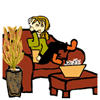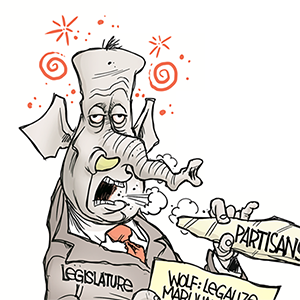Virginia's bat population is shrinking. Here's why it matters
Published in News & Features
Bats are one of Halloween’s most famous symbols, but their real job is an important part of ecosystems and agriculture.
One William & Mary professor hopes the public can learn to appreciate the flying mammals year-round.
“Here in the US, there’s 47 species, and relatively speaking they’re all small, and they’re often hidden at night,” said Dave Waldien, a visiting assistant teaching professor in William & Mary’s Department of Biology. “Sometimes we see them when we’re out in the evening, around the light or something, but for the most part, they’re hidden from us.
“But they are being devastated here in the U.S., from habitat loss and white-nose disease, killing millions of hibernating bats here in the United States and North America.”
Waldien has studied the furry fliers for more than two decades, and he leads a team of students that are contributing to conservation research for bats. Their work includes updating Red List assessments, which evaluate the risk of extinction for animals, fungi and plants. It includes information on the species’ range, population size, habitat, threats and conservation actions.
If you enjoy fresh fruit or an occasional shot of tequila — thank a bat, Waldien said. They’re responsible for pest and insect control, and there are species of bats that are credited with keeping plants pollinated, such as the tequila bat. According to the U.S. Department of the Interior, they feast on insects each night, adding up to more than $3.7 billion worth of pest control each year. More than 300 species of fruit depend on bats for pollination.
There are more than a dozen species that call Virginia home, including the Virginia big-eared bat, the Seminole bat and the evening bat.
“Bats are really an underappreciated, often-overlooked species that are sometimes maligned and people fear them,” Waldien said. “There are lots and lots of threats from major wildlife diseases like white-nose syndrome here in the U.S. to wholesale habitat destruction and degradation, deforestation and loss of critical root sites underground. Caves and mines are often some of those big drivers (of habitat loss).
“With the work we do, I feel very fortunate with my career and now working with students at William & Mary, be able to both do the background work to help set species up and partners up for applied conservation.”
Originating in Europe, white-nose syndrome has killed millions of bats in North America, including roughly 90% of some species. Researchers call the disease “white-nose syndrome” because of the visible white fungal growth on infected bats’ muzzles and wings, according to the National Park Service. The syndrome infects bats during hibernation, when they reduce their metabolic rate and lower their body temperature to save energy over winter. Hibernating bats affected by the fungus wake up to warm temperatures more frequently, which results in using up fat reserves and then starvation before spring arrives.
As for habitat loss, Waldien works to ensure that bats are considered when key biodiversity areas are identified.
“What people can do (at home) is just be aware of them to begin with, and get informed on what bats do for the environment upon which people depend — like the assisted services to the foods that we love to eat,” he said. “There’s things to do for educating yourself, helping to educate or raise the awareness of others. One of the strategies people have are offsetting some of the devastating impact of white-nose syndrome, which hits where they winter, they go into hibernation.
“You can help them out by limiting disturbance in those sites, (and) you can help them out during the summer by considering putting up a bat house for colonies and providing that space to roost there.”
In some areas, residents can also get involved with public monitoring for bats, as well.
“I think during Halloween, and as we go forward, we need that raised awareness and folks looking for opportunities to contribute to that conservation,” Waldien said.
_____
©2024 The Virginian-Pilot. Visit pilotonline.com. Distributed by Tribune Content Agency, LLC.







Comments